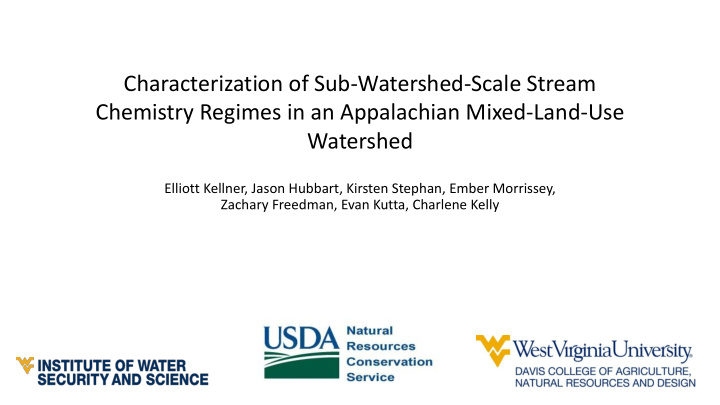



Characterization of Sub-Watershed-Scale Stream Chemistry Regimes in an Appalachian Mixed-Land-Use Watershed Elliott Kellner, Jason Hubbart, Kirsten Stephan, Ember Morrissey, Zachary Freedman, Evan Kutta, Charlene Kelly
Introduction • Studies have linked anthropogenic landscape alteration to streamwater quality degradation. • pH • Conductivity • Temperature • Nutrient Loading • Trace Element Concentrations • Water quality regimes are affected by competing natural and anthropogenic factors, and can thus be difficult to manage in contemporary watersheds. • Few studies have focused on 1 st - 4 th order streams, which represent approximately 97% of U.S. stream-length. • Managers need methodological approaches for detailed spatial and temporal characterization of water quality regimes of low order streams.
West Run Watershed • Morgantown, WV • Mixed-Land-Use, with rapid urbanization • Experimental Watershed Study • Nested-Scale and Paired • Begun in Spring of 2016 • Activities • Hydroclimate monitoring • Stream chemistry analysis • E. coli monitoring • Suspended sediment characterization • Physical habitat assessment • Microbial dynamics
Methods • Study focused on six core sites • 1: Upper station on mainstem of West Run Creek • 2: Mixed-land-use • 3: Urban • 4: Agriculture • 5: Forest • 6: Lower station on mainstem of West Run Creek • Weekly grab samples • Analyzed for elemental composition • ICP-OES • Spectrophotometer • 23 separate parameters • Data analyzed via suite of statistical methods • Hypothesis testing • Correlation analysis • Principle Components Analysis (PCA)
Results • Increasing streamflow volume with increasing stream distance • Significant differences (p < 0.05) between study sites were identified for every measured parameter except Cu concentration • Different parameters showed significant differences (p < 0.05) between different site pairings • Sites displayed fairly consistent (i.e. over time) relative differences for the measured parameters
Results • Site #1 • Lowest pH (median = 5.1) • High Specific Conductance (median = 872 µs cm -1 ) • Highest concentrations of Al, Fe, Mn, S, and Zn • High concentrations of Ca and Mg • Site #2 (Mixed-Use) • Low pH (median = 6.8) • High concentrations of Fe, Mn, and S • Highest concentrations of Co (median = 0.03 mg L -1 ) • Site #3 (Urban) • Highest pH and Specific Conductance (median = 8.2 and 1055 µs cm -1 , respectively) • High concentrations of Ca, Mg, Pb, and Sr • Highest concentrations of Na (median = 50.53 mg L -1 )
Results • Site #4 (Agriculture) • Highest concentrations of K and P (median = 9.02 mg L -1 and 0.52 mg L -1 , respectively) • Low Specific Conductance and Dissolved Oxygen (median = 372.6 µs cm -1 and 89.7 % saturation, respectively) • Low concentrations of several elements (e.g. Ca, Fe, Mg, Mn, Na, S, and Zn) • Site #5 (Forest) • Lowest Specific Conductance (median = 232.7 µs cm -1 ) • High pH (median = 7.9) • Lowest concentrations of several elements (e.g. Ca, Fe, K, Mg, Mn, Na, and S) • Site #6 • Intermediate pH (median = 7.1) • Concentrations of Al, Co, Fe, Mn, S, and Zn similar to those of sites #1 and #2 • Specific Conductance and concentrations of Ca, Mg, and Pb similar to those of sites #1 and #3
Results • PCA • 6 components explained 86% of the cumulative variance of the water quality dataset • Principle components 1 and 2 represent water quality patterns associated with development and AMD, respectively • Principle components 3 and 4 represent water quality patterns associated with agricultural and forest land uses • Correlation Analyses • Varying significant (p< 0.05) relationships between chemical parameters and hydroclimate metrics • Certain parameters (e.g. Ca, Sr, specific conductance) displayed greater sensitivity to hydroclimate at mixed-land-use sites
Discussion/Conclusions • Land use characteristics and associated hydrologic regime contrasts are likely the primary factors contributing to the observed results. • Increased values of various parameters (e.g. Ca, Mg, Na, specific conductance) attributable to developed land use • Reduced elemental concentrations attributable to forest cover • Results demonstrate the utility of Principle Components Analysis (PCA) for water quality research • Ability of the method to quickly “map” water quality patterns at the sub -watershed scale • Potential mechanistic associations between parameters, such as Na concentration and SPC and developed land uses • Weak correlations between elemental concentrations and streamflow metrics • Non-linear relationships between streamflow and dissolved constituents • Contrasting flow regimes between sites • Results emphasize the utility of the approach for detailed characterization of water quality regimes in low order streams. • Despite the brief study duration, results describe consistent characteristics of the study streams, which can be used to more effectively target sub-watershed-scale remediation and/or restoration efforts
Acknowledgements • This work was supported by: • The National Science Foundation under Award Number OIA-1458952 • USDA National Institute of Food and Agriculture (Hatch project accession numbers 1011536, 1010898, and 1011670, and McIntire Stennis project accession numbers 1011951 and WVA00120) • West Virginia Agricultural and Forestry Experiment Station • Natural Resources Conservation Service, U.S. Department of Agriculture, under award number 68-3D47-18-005 • Results presented may not reflect the views of the sponsors and no official endorsement should be inferred. • Any opinions, findings, conclusions, or recommendations expressed in this publication are those of the author(s) and do not necessarily reflect the views of the U.S. Department of Agriculture. • The funders had no role in study design, data collection and analysis, decision to publish, or preparation of the manuscript. • Scientists of the Interdisciplinary Hydrology Laboratory (www.forh2o.net)
Recommend
More recommend